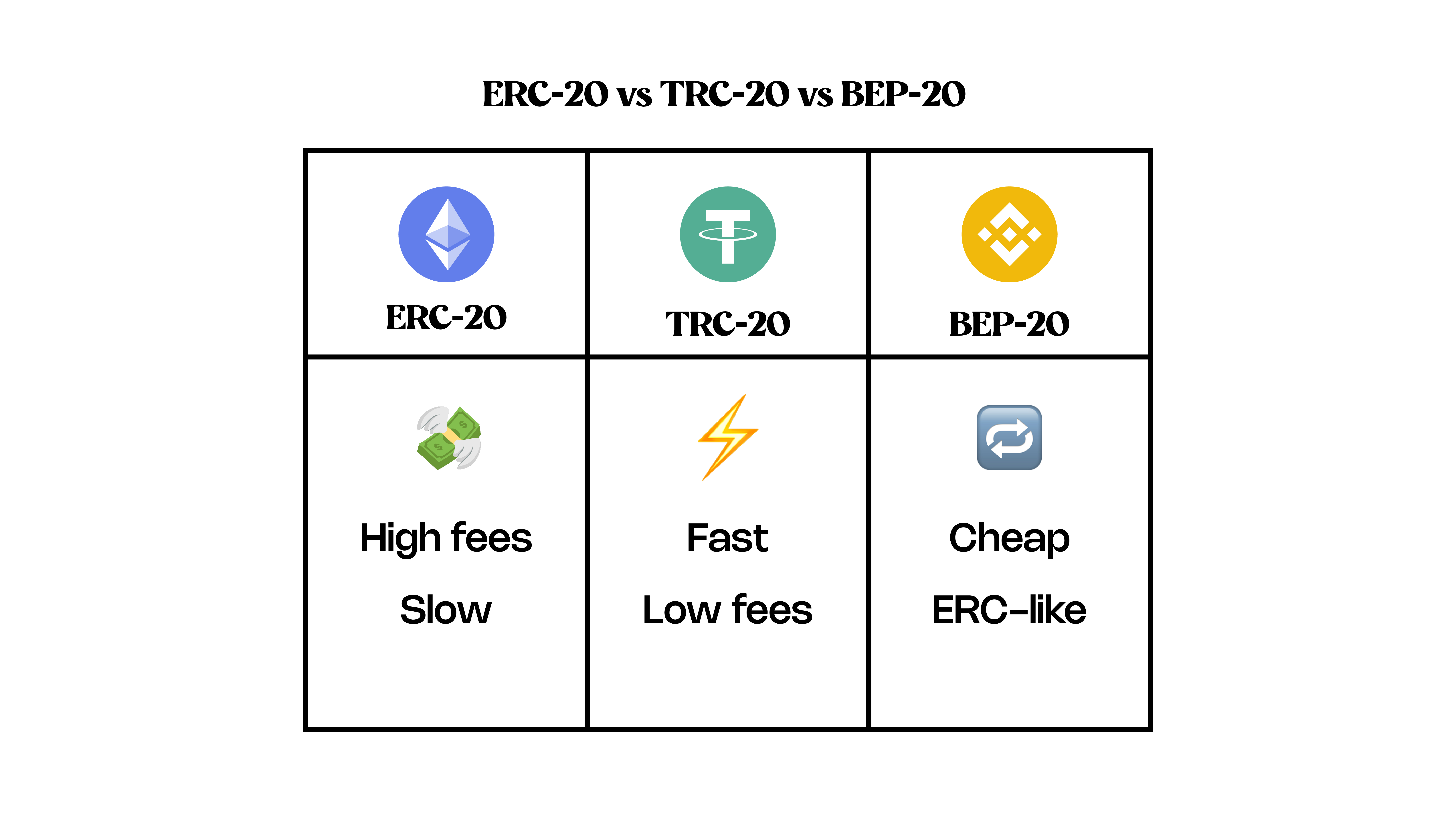
Have you ever tried sending USDT and got hit with different options like ERC-20, TRC-20 and BEP-20? Maybe you picked one and completed the transaction. But somewhere along the line, you probably paused, took a deep breath and asked, “Wait o, what do all these -20 codes actually mean?”
Let’s break it down. These terms aren’t just crypto gibberish. They are called token standards and significantly affect how fast, cheap, and smooth your transactions are.
Here’s the Gist
- ERC-20 is a token standard based on the Ethereum Blockchain
- TRC-20 tokens run on the TRON blockchain.
- BEP-20 is a BNB Smart Chain token standard
- TRC-20 and BEP-20 are your best bets for fast, cheap USDT transactions.
- Vent App supports TRC-20 and BEP-20 so you can sell USDT for Naira without stress.
What’s a Token Standard?
A token standard is like a rulebook that specifies the requirements that must be satisfied to ensure a token's compatibility with the underlying blockchain and its interoperability with its applications.
Let’s break it down. A token is a digital currency built on a blockchain. Different types of cryptocurrency tokens exist, such as utility tokens and stablecoins. In most cases, projects interested in creating a token simply find an existing chain to build on rather than building their blockchain from scratch.
This is where token standards come in. It tells the token how to act on the blockchain, move, and interact with wallets and exchanges. Think of it this way: the token is your car, and the standard is the road it follows.
There are different blockchains with different token standards. Generally, Ethereum (ERC-20, ERC-721, ERC-777, ERC-115), Binance Smart Chain (BEP-20), and TRON (TRC-20, TRC-721, TRX, TRC-10) are the most popular blockchains for developing tokens.
However, the following three token standards stand out for USDT and other tokens:
- ERC-20 on Ethereum
- TRC-20 on TRON
- BEP-20 on Binance Smart Chain (BSC)
Let’s break each one down.
ERC-20: Ethereum’s OG Format
ERC-20 is the oldest and most popular token standard. It runs on the Ethereum blockchain and powers thousands of tokens, including Uniswap (UNI) and Chainlink (LINK).
ERC means Ethereum Request for Comment, and “20” stands for the 20th proposal to the network by a developer named Fabian Vogelsteller. He submitted it as a standard interface for tokens on the Ethereum blockchain. And that’s basically a set of rules that tokens like USDT could follow to ensure compatibility across wallets, exchanges and apps.
ERC-20 tokens are fungible. A token is fungible when it is equal and indistinguishable from another token of the same kind. As ERC-20 is one of the oldest and most trusted token standards, ERC-20 is supported by almost every wallet and exchange.
Moreover, transactions involving ERC-20 tokens are fast and effective, and the contract-breaking risk is low. ERC-20 tokens are usually user-friendly and very secure.
TRC-20: Built for Speed on TRON
TRC-20 runs on the TRON blockchain. This token standard is your guy if you’re all about speed and low fees. With a block time of just 3 seconds, you can send USDT using TRC-20 and get confirmation faster than you can say “otilor.” Plus, the network fees are almost zero.
TRON uses Solidity, the same smart contract language used on Ethereum. So you can think of TRC-20 as a faster, cheaper version of the Ethereum blockchain. That’s why TRC-20 is one of the most popular networks for USDT transactions, especially on platforms like Vent.
BEP-20: Binance’s Budget-Friendly Option
BEP-20 runs on the BNB Smart Chain (BSC), which Binance built. It copies the ERC-20 format but makes it faster and more affordable. Currently, BEP-20 is the second most popular crypto token standard, as many new tokens are being developed on BSC because it is quicker, cheaper, more efficient, and supports cross-chain compatibility.
If ERC-20 is the OG, we can call BEP-20 the younger and brighter sibling. As such, you can use the Binance Smart Chain (BEP-20) to transfer ERC-20 tokens faster and at a very low cost. Similarly, many other tokens, like Bitcoin, Ether, Litecoin, and USDT, can also be transferred using BEP-20. Another advantage of the BEP-20 token system is that many wallets support it.
It’s ideal for sending crypto without high gas fees. You can use it for USDT, BTC, ETH, and more. And the best part? Most wallets support BEP-20 already, so you’re good to go. For a smooth, low-cost transaction, BEP-20 is a solid pick, especially for crypto-to-cash swaps.
Swap Your USDT to Naira
Vent is your surest crypto-to-cash plug. The Vent app supports TRC-20 and BEP-20 for USDT transactions because they’re faster, cheaper, and easier to use. On the Vent App, you can swap USDT (TRC-20 or BEP-20) to Naira in seconds with zero fees.
You get:
- Fast delivery
- Trusted platform
- No extra charges
Ready to cash out like a boss?
👉 Sign up now. You can download the Vent app on the App Store or the Play Store.


